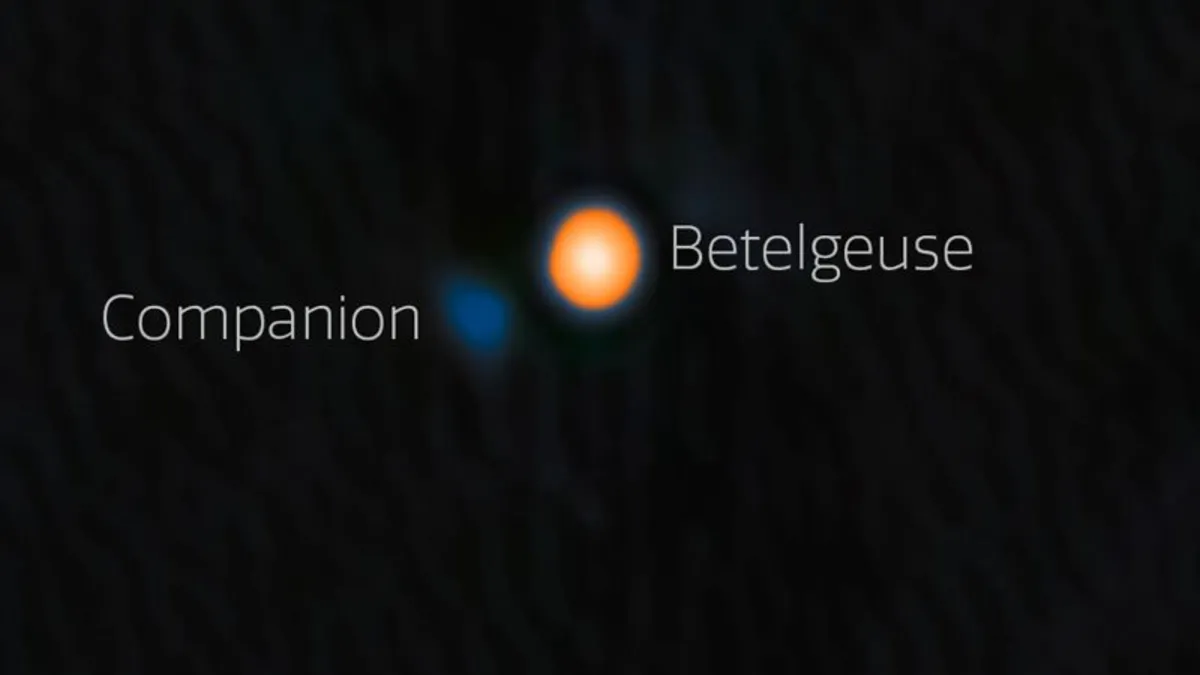
Astronomers have made a groundbreaking observation of what they believe to be a never-before-seen companion star orbiting Betelgeuse, a pulsating red supergiant star located in the shoulder of the Orion constellation. Known for its captivating reddish hue, which is visible to the naked eye, Betelgeuse ranks among the most luminous stars in the night sky. Its changing brightness has fascinated astronomers for decades, and this latest discovery may hold the key to understanding why.
From late 2019 to early 2020, Betelgeuse experienced a dramatic dimming event, leading astronomers to speculate that the star was on the verge of exploding in a supernova. This phenomenon, referred to as the “Great Dimming,” resulted in increased scrutiny of Betelgeuse. Following extensive research, astronomers concluded that a significant dust cloud ejected by the star temporarily obstructed some of its light from reaching Earth. This event spurred an interest in solving the longstanding mysteries surrounding this remarkable celestial object.
Betelgeuse has been known to exhibit a predictable brightness fluctuation approximately every six years, a pattern that has puzzled astronomers for decades. A research team has recently proposed an explanation for this phenomenon. Utilizing an advanced instrument on the Gemini North telescope in Hawaii, they employed an innovative imaging technique that led to the detection of a suspected companion star, affectionately nicknamed “Betelbuddy.” The team has suggested the Arabic name “Siwarha,” meaning “her bracelet,” to reflect its relationship with Betelgeuse, which translates to “Hand of the Giant.”
As a supergiant star, Betelgeuse is colossal, boasting a radius approximately 700 times that of our sun and containing about 18 times its mass. If Betelgeuse were to replace our sun, it would engulf not only Earth but also the inner planets, extending past Jupiter’s orbit. It shines with a brilliance that is 7,500 to 14,000 times greater than that of the sun. Despite being only 10 million years old—a mere fraction of the sun's estimated age of 4.5 billion years—Betelgeuse has exhausted its core hydrogen supply, leading to its expansion as it approaches the end of its life.
Years of astronomical observations have indicated that Betelgeuse's luminosity varies periodically, with a cycle of approximately 416 days—a behavior characteristic of red supergiant stars. However, the star also exhibits a longer period of variation of about 2,170 days, or roughly six years, which had remained unexplained until recent studies. Two independent groups of astronomers suggested in 2024 that an unseen companion star could be responsible for this variability, although previous observations from the Hubble Space Telescope and NASA’s Chandra X-Ray Observatory found no evidence of such a star.
The challenges of detecting a companion star are significant due to Betelgeuse’s immense brightness and size. To observe both Betelgeuse and its companion, high-resolution and high-contrast imaging is essential. Howell's team utilized a speckle imager called ‘Alopeke’—meaning “fox” in Hawaiian—to search for the companion star. Speckle imaging captures thousands of brief exposures, which are processed to eliminate atmospheric distortions, resulting in a clear, high-resolution image.
During the Great Dimming in 2020, Howell's team did not detect the companion star, likely because it was obscured by Betelgeuse. However, in December, they noticed a faint blue glow at a predicted location, confirming the presence of the companion star. This young, bluish star, which has a mass of 1.5 times that of the sun, is not yet burning hydrogen at its core and is only four-tenths of one percent as bright as Betelgeuse. The proximity of the two stars, just four times the distance between Earth and the sun, makes detection particularly challenging.
The discovery of the companion star aligns with prior research predictions but requires further observations for verification. Speckle imaging is a difficult measurement technique, and the companion's presence is deemed probable but not yet confirmed. Future observations are planned for November 2027 when the companion star will be at its farthest distance from Betelgeuse, making it easier to spot.
Current models suggest that Betelgeuse wobbles towards and away from Earth over a six-year period due to the gravitational influence of its companion star. This relationship may explain the star’s brightness fluctuations, which are likely connected to changes in surrounding dust. As the companion star orbits, it may influence the dust dynamics around Betelgeuse, contributing to the observed variability.
As astronomers ponder the eventual fate of Betelgeuse, they acknowledge that the companion star may face a grim future. Over the next 10,000 years, the companion’s orbit could cause it to drift closer, potentially leading to a dramatic collision with Betelgeuse. Alternatively, if Betelgeuse were to explode in a supernova before this occurs, the companion star would be obliterated. Regardless of the outcome, the study of this stellar pair offers valuable insights into stellar evolution and the dynamics of star formation.
This remarkable discovery serves as a reminder that even the most studied stars in our night sky continue to reveal new mysteries, highlighting the importance of ongoing astronomical research.